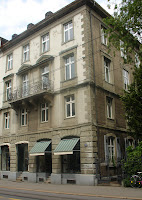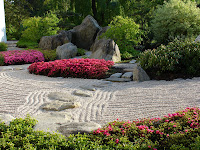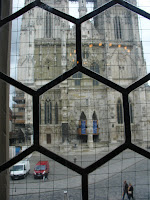 We're quite unused to such brilliance day after day and it quite changes everyone's outlook. You can sit in the garden until late in the evening, keep the windows open wide all night, and dress in the morning without shivering.
We're quite unused to such brilliance day after day and it quite changes everyone's outlook. You can sit in the garden until late in the evening, keep the windows open wide all night, and dress in the morning without shivering. The Spanish lavender is in bloom and this year we are blessed with more honey bees than we've seen in a few years. They had almost disappeared last year. I thought this was the reason that we had no plums last year on a tree that produces the sweetest plums I've ever tasted. We have every sign of a good crop this year.
We continue in quiet practice through the month of June until we enter an intense practice period through the month of July. C.J. Jikyo Wolfer will be our Shuso, Head Monk, for this practice period. She will lead Zazen, give Dharma talks, and essentially lead the Sangha in practice. An intensive sesshin will be held from July 18 to 26 and will culminate in a Shuso Ceremony on the 26th at 2:00 p.m. At this Ceremony, the Sangha, visiting priests, and friends will have the opportunity to question Shuso on her understanding of the Dharma. We will spend about an hour, throwing questions at her that challenge her rootedness in Mu, her rootedness in Dharma. It is also an excellent opportunity for Sangha to dig into their own understanding and find questions that they also have found difficult to answer. It is a day of high energy and great happiness in witnessing a novice progress on the road to becoming a priest.
I continue to write and paint. In the mornings I get something into the sketch book and keep it on the counter in case I get a feeling to scribble something else as the day goes on. I'm feeling a better rhythm in letting poems also appear. It's not so easy to allow image making in fine art and image making in poetry to flow together and to come out simultaneously. But, that's my practice of late. Keeping both going rather than being on one side of expression or the other for various periods of time. It's a little bit like being in love with two people at the same time.
Our visiting teacher last weekend said that he thought we talked too much in the U.S. Too many Dharma talks, he said. I kind of agree. Maybe even too much talking via blogs. So, last Wednesday night we sat two periods of Zazen and then I gave a five minute encouragement talk. Very briefly, here's a paraphrase of what I said: because we are not fully realized, a fully Awakened Buddha, we believe we need a 'self' and we create a 'self' very often via our thinking capacities. When we think of "self" we think of consciousness or mind as that which defines us. But, the Buddha pointed out that it was much wiser to take the physical body as the self rather than the mind, or consciousness, because the body was slower, more settled, solid. Our minds are moving very quickly and our thoughts change very rapidly, much much faster than does the body change. Also, if we must think of a self, by placing the notion of self in the body, we can release ourselves more easily from the tyranny of thoughts and be more equanimous moment by moment. That is a moment of the Buddha's sweet wisdom.
Thank you. I'm off to the sunshine.















 ming out of the chimney and after awhile it seemed to be ready to travel. This train is moved from place to place to recall the plight of the Jewish children who were removed from their families and sent into work camps.
ming out of the chimney and after awhile it seemed to be ready to travel. This train is moved from place to place to recall the plight of the Jewish children who were removed from their families and sent into work camps. 













